 W
WThe 1821 Derby at Epsom, or Horse Race is an 1821 painting by Théodore Géricault in the Louvre Museum, showing The Derby of that year.
 W
WBetween Rounds is an 1899 painting by American artist Thomas Eakins, Goodrich #312. It is part of the collection of the Philadelphia Museum of Art.
 W
WBoth Members of This Club is an oil painting by George Bellows. It hangs in the National Gallery of Art in Washington DC. It dates to 1909 and measures 115 cm × 160.5 cm.
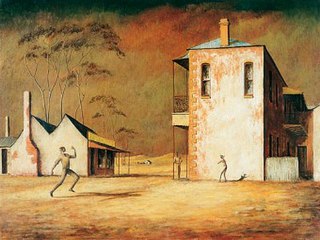 W
WThe cricketers is a 1948 painting by the Australian artist Russell Drysdale. The painting depicts three boys set among the buildings in an empty town; two playing cricket and the other watching them. The National Gallery of Australia describes the painting as "one of the most original and haunting images in all Australian art." The Sydney Morning Herald said the work is "possibly the most famous Australian painting of the 20th century."
 W
WThe Croquet Game is an 1873 oil on canvas painting by Édouard Manet, now in the Städel Museum in Frankfurt. It shows a group of people playing croquet, a very fashionable game at that time. The group comprises the painter Alfred Stevens, artists' models Victorine Meurent and Alice Legouvé and, in the background, Manet's friend Paul Rodier.
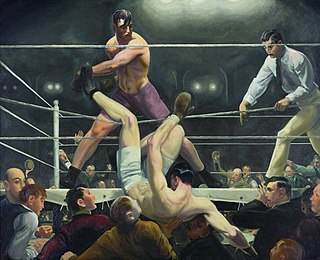 W
WDempsey and Firpo is a 1923–1924 oil canvas painting by George Bellows, depicting the September 14, 1923 boxing match between American Jack Dempsey and Argentine Luis Firpo. As time passed by it has become Bellows' most famous painting. The work has been in the collection of the Whitney Museum of Art since the museum's opening in 1931.
 W
WDynamism of a Soccer Player is a 1913 Futurist painting by Italian artist Umberto Boccioni (1882–1916). It is currently held in the Museum of Modern Art in New York.
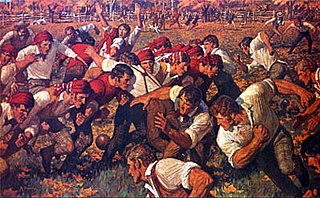 W
WThe First Game is a painting by Arnold Friberg, and was commissioned in 1968 by Chevrolet Motor Division as one of four paintings to commemorate the then-upcoming centennial celebration of college football in the United States. It depicts the famous first game of American intercollegiate football, played by Rutgers College and the visiting College of New Jersey on November 6, 1869, at College Field in New Brunswick, New Jersey. The game was played in front of approximately 100 spectators, who were also depicted on the picture.
 W
WFootballer is a 1946 painting by Australian artist Sidney Nolan. It depicts an Australian rules footballer standing before a crowd of spectators at a football match. For many years the painting was thought to be a generic image of a footballer, however Nolan later revealed that the painting is based on Bill Mohr, a star player for the St Kilda Football Club during the 1930s.
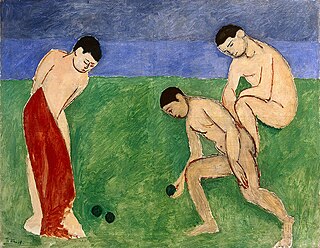 W
WGame of Bowls is a 1908 painting by the French artist Henri Matisse. The painting shows three young men, probably Matisse's sons and nephew, playing a game of Boules. Matisse sees the game as a manifestation of man's creativity, and an instrument to use in understanding the codes of life. The painting is part of Matisse's series on man's "Golden Age" and was part of Sergei Shchukin's collection before the October Revolution of 1917. It is now in the collection of The Hermitage, St. Petersburg, Russia.
 W
WGolf Ball is a 1962 painting by Roy Lichtenstein. It is considered to fall within the art movement known as Pop art. It depicts "a single sphere with patterned, variously directional semi-circular grooves." The work is commonly associated with black-and-white Piet Mondrian works. It is one of the works that was presented at Lichtenstein's first solo exhibition and one that was critical to his early association with pop art. The work is commonly critiqued for its tension involving a three-dimensional representation in two dimensions with much discussion revolving around the choice of a background nearly without any perspective.
 W
WThe Golf Players (1658) is an oil on panel painting by the Dutch painter Pieter de Hooch, it is an example of Dutch Golden Age painting and is part of the collection of Polesden Lacey.
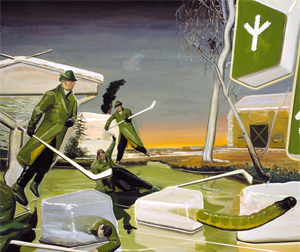 W
WHunt is a 2002 painting by the German artist Neo Rauch. It depicts a group of flying men in green coats and hats playing ice hockey among large ice cubes.
 W
WLes Joueurs de football, also referred to as Football Players, is a 1912–13 painting by the French artist, theorist and writer Albert Gleizes. The work was exhibited at the Salon des Indépendants, Paris, March–May 1913. September through December 1913 the painting was exhibited at Erster Deutscher Herbstsalon, Berlin. The work was featured at Galeries Dalmau in Barcelona, 29 November – 12 December 1916, Gleizes' first one-person show. The work was again exhibited at Galeries Dalmau 16 October – 6 November 1926. Stylistically Gleizes' Football Players exemplifies the principle of mobile perspective laid out in Du "Cubisme", written by himself and French painter Jean Metzinger. Guillaume Apollinaire wrote about Les Joueurs de football in an article titled "Le Salon des indépendants", published in L'Intransigeant, 18 March 1913, and again in "A travers le Salon des indépendants", published in Montjoie!, Numéro Spécial, 18 March 1913.
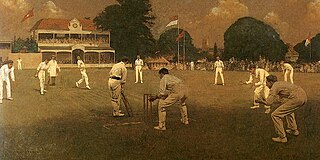 W
WKent vs Lancashire at Canterbury is an oil on canvas painting by Albert Chevallier Tayler completed in 1907. It was commissioned by the Kent County Cricket Club at the suggestion of chairman Lord Harris to celebrate their first County Championship title win. Tayler painted the picture after taking individual sittings with each of the Kent players. With the exception of short-term loans, the painting remained at the St Lawrence Ground until 1999, at which time it was moved to the Lord's Pavilion as Kent could no longer afford the insurance. In 2006, Kent sold the painting to a charity foundation at an auction. The piece is currently on display at Lord's Cricket Ground in London.
 W
WMax Schmitt in a Single Scull is an 1871 painting by Thomas Eakins, Goodrich catalogue #44. It is in the permanent collection of the Metropolitan Museum of Art. Set on the Schuylkill River in Philadelphia, Pennsylvania, it celebrates Eakins's friend Max Schmitt's victory in the October 5, 1870, single sculls competition.
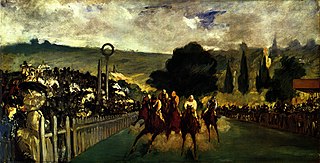 W
WThe Races at Longchamp is an 1866 painting by the French artist Édouard Manet. The Impressionist painting depicts a horse racing at Longchamp and is currently conserved at the Art Institute of Chicago. It has been exhibited many times, the first one at the École nationale supérieure des Beaux-Arts in Paris in January 1884.
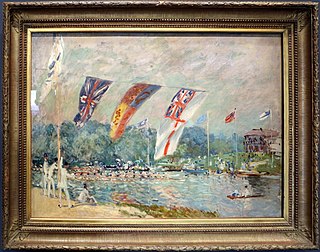 W
WRegatta at Molesey near Hampton Court is an 1874 painting by Alfred Sisley, now in the Musée d'Orsay, to which it was allocated in 1986. It was left to the French state by the painter and collector Gustave Caillebotte in 1894 and previously hung in the Musée du Luxembourg (1896-1929), the main building at the Louvre (1929-1947) and the Louvre's galerie du Jeu de Paume (1947-1986).
 W
WThe Regatta at Sainte-Adresse is an oil-on-canvas painting by the impressionist painter Claude Monet. It was painted in 1867 and is owned by the Metropolitan Museum of Art.
 W
WThe Rookie or The Rookie is a 1957 painting by American artist Norman Rockwell, painted for the March 2, 1957, cover of The Saturday Evening Post magazine.
 W
WSalutat is an 1898 painting by Thomas Eakins (1844–1916). Based on a real-life boxing match that occurred in 1898, the work depicts a boxer waving to the crowd after the match. According to Eakins' biographer Lloyd Goodrich, Salutat is "one of Eakins' finest achievements in figure-painting." The painting's title is Latin for "He greets" or "He salutes."
 W
WThe Reverend Robert Walker Skating on Duddingston Loch, better known by its shorter title The Skating Minister, is an oil painting attributed to Henry Raeburn in the Scottish National Gallery in Edinburgh. It was practically unknown until about 1949, but has since become one of Scotland's best-known paintings. It is considered an icon of Scottish culture, painted during one of the most remarkable periods in the country's history, the Scottish Enlightenment.
 W
WSkittle Players outside an Inn is an oil on oak panel painting by the Dutch artist Jan Steen, probably painted between 1660 and 1663 during his time in Haarlem. It depicts the playing of a skittles game, and is now in the National Gallery, London, to which it was bequeathed in 1910 by George Salting.
 W
WStag at Sharkey's is a 1909 oil painting by George Wesley Bellows depicting two boxers fighting in the private athletic club situated across from his studio. It is part of the Ashcan School movement known in particular for depicting scenes of daily life in early twentieth century New York City, often in the city's poorer neighborhoods. Participants in the boxing ring were usually members of the club, but occasionally outsiders would fight with temporary memberships. These fighters were known as "stags".
 W
WTaking the Count is an 1898 painting by American artist Thomas Eakins. It is part of the collection of the Yale University Art Gallery.
 W
WThree of the Players is a 1953 painting by Australian artist John Brack. The painting depicts three Australian rules footballers from the Collingwood Football Club. The players are thought by some to be Lou Richards, Jack Regan and Phonse Kyne. However, Brack's widow, Helen, was of the opinion that they are not recognisable individuals but "stereotyped characters".
 W
WTough Call – also known as Game Called Because of Rain, Bottom of the Sixth, or The Three Umpires – is a 1948 painting by American artist Norman Rockwell, painted for the April 23, 1949, cover of The Saturday Evening Post magazine. The original painting is in the collection of the National Baseball Hall of Fame. It is considered the best known of Rockwell's baseball-themed works, and appears in at least ten Rockwell commentary books.
 W
WThe University of Texas National Championship 2005 is a painting by Opie Otterstad. It was commissioned in 2006 by The University of Texas at Austin to commemorate the 2005 Texas Longhorns football team who won the 2005 NCAA Division I-A national football championship in college football. The Longhorns secured the championship by defeating the University of Southern California Trojans in the 2006 Rose Bowl.
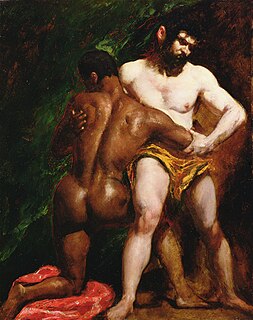 W
WThe Wrestlers is an oil painting on millboard by English artist William Etty, painted around 1840 and currently in the York Art Gallery, in York, England. It depicts a wrestling match between a black man and a white man, both glistening with sweat and under an intense light emphasising their curves and musculature. While little documentation of the painting exists prior to 1947, it is likely that it was painted over a period of three evenings at the life class of the Royal Academy.
 W
WThe Wrestlers is a 1905 oil painting by George Luks held at the Museum of Fine Arts, Boston in Massachusetts, United States. The Wrestlers is Luks' best-known work. The painting depicts two nude men wrestling. He painted it in order to shock members of the Pennsylvania Academy of the Fine Arts whom he called "pink-and-white idiots". The Wrestlers was displayed at the 1908 Ashcan School exhibition. A 1910 article in New York World about the Exhibition of Independent Artists included an image of Luks' The Wrestlers despite the fact that the painting did not appear in that exhibition. In a 1908 diary entry, painter John French Sloan writes that The Wrestlers is among the best paintings he ever encountered. In 1992, art critic Carol Clark identified The Wrestlers as one of Luks' best works, calling it "raw, roughly painted" and reflective of Luks' experiences in New York. In 1996, Allen Guttmann compared Luks' The Wrestlers to Thomas Eakins' Wrestlers and Max Slevogt's Wrestling School, writing that all three paintings depict pairs of nude wrestling men lying on the ground in grappling holds. In the 2009 Dictionary of Modern and Contemporary Art, Ian Chilvers and John Glaves-Smith write that The Wrestlers emulates the "bravura painterly technique of artists such as Manet".
 W
WWrestlers is a name shared by three closely related 1899 paintings by American artist Thomas Eakins,. The Los Angeles County Museum of Art (LACMA) owns the finished painting (G-317), and the oil sketch (G-318). The Philadelphia Museum of Art (PMA) owns a slightly smaller unfinished version (G-319). All three works depict a pair of nearly naked men engaged in a wrestling match. The setting for the finished painting is the Quaker City Barge Club (defunct), which once stood on Philadelphia's Boathouse Row.
 W
WThe Wrestlers is a large 1853 painting by Gustave Courbet, now in the Museum of Fine Arts in Budapest. It shows two men engaged in 'French wrestling', inspired by Greco-Roman wrestling. Documents reveal that it shows a match in the former hippodrome on the Champs-Élysées in Paris. His choice of such a huge canvas inspired Alexandre Falguière's 1875 The Wrestlers.